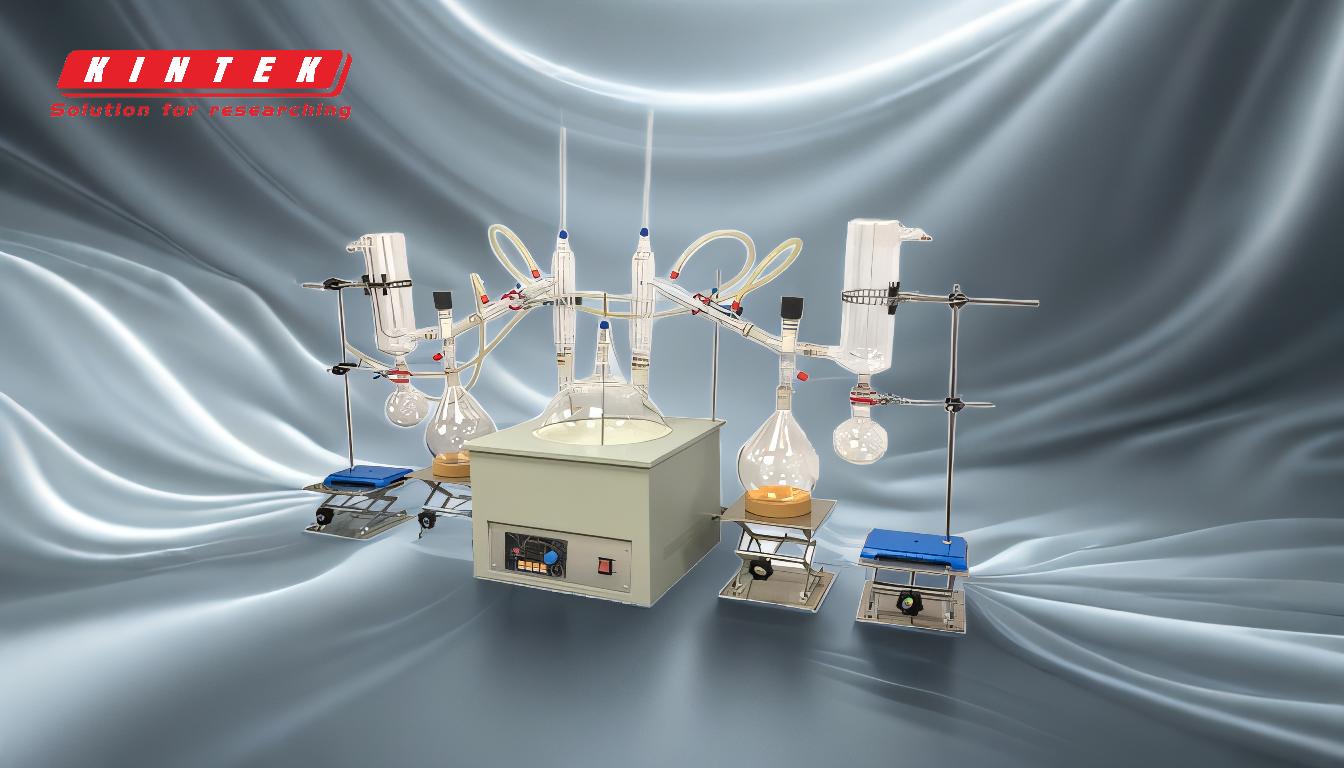To perform a distillation experiment, the equipment required varies depending on the type of distillation being conducted, such as fractional distillation, vacuum distillation, or short-path distillation. The core components typically include a distillation flask, a heat source, a condenser, a receiving flask, and a thermometer. For more specialized distillation methods like vacuum or short-path distillation, additional equipment such as vacuum pumps, chillers, and rotary evaporators may be necessary. The choice of equipment depends on the specific requirements of the experiment, including the boiling points of the substances being distilled and the level of precision needed in the separation process.
Key Points Explained:

-
Distillation Flask:
- The distillation flask, often a round-bottom flask, is where the liquid mixture is placed. It is heated to induce boiling, causing the components to vaporize at their respective boiling points. The flask must be made of heat-resistant material, such as borosilicate glass, to withstand high temperatures.
-
Heat Source:
- A heat source is essential to provide the energy needed to vaporize the liquid mixture. Common heat sources include:
- Hot Plates or Heating Mantles: Used for precise temperature control.
- Water or Oil Baths: Provide uniform heating and are suitable for temperature-sensitive substances.
- Bunsen Burners: Used for simple distillation setups but offer less precise temperature control.
- A heat source is essential to provide the energy needed to vaporize the liquid mixture. Common heat sources include:
-
Condenser:
- The condenser cools the vaporized components, converting them back into liquid form. There are several types of condensers:
- Liebig Condenser: A straight tube surrounded by a water jacket, commonly used for simple distillation.
- Graham Condenser: A coiled tube within a water jacket, offering a larger cooling surface.
- Chilled Condenser: Used in short-path distillation, where the condenser is cooled to very low temperatures to collect volatile components.
- The condenser cools the vaporized components, converting them back into liquid form. There are several types of condensers:
-
Receiving Flask:
- The receiving flask collects the condensed liquid (distillate) after it passes through the condenser. It is typically a round-bottom or Erlenmeyer flask, depending on the volume of distillate expected.
-
Thermometer:
- A thermometer is used to monitor the temperature of the vapor as it rises through the distillation apparatus. This is crucial for determining the boiling points of the components and ensuring the separation process is effective.
-
Fractionating Column (for Fractional Distillation):
- In fractional distillation, a fractionating column is placed between the distillation flask and the condenser. This column contains packing material (e.g., glass beads or metal mesh) that provides a large surface area for vapor to condense and re-evaporate, enhancing the separation of components with similar boiling points.
-
Vacuum Pump (for Vacuum Distillation):
- Vacuum distillation requires a vacuum pump to reduce the pressure inside the distillation system. Lowering the pressure decreases the boiling points of the components, allowing for the distillation of heat-sensitive substances without decomposition.
-
Rotary Evaporator (for Specialized Distillation):
- A rotary evaporator (rotovap) is used in applications like cannabis distillation or when working with small volumes. It consists of a rotating flask, a vacuum pump, and a condenser. The rotation increases the surface area of the liquid, speeding up evaporation, while the vacuum lowers the boiling point.
-
Chiller or Cooling Water Source:
- A chiller or cold water bath is used to cool the condenser, ensuring efficient condensation of the vapor. In some setups, a recirculating chiller is used to maintain a consistent cooling temperature.
-
Vacuum Controller (for Precision):
- A vacuum controller is used in advanced setups to precisely regulate the pressure inside the distillation system. This is particularly important in vacuum and short-path distillation, where maintaining a specific pressure is critical for effective separation.
-
Short-Path Distillation Setup:
- Short-path distillation involves a specialized setup where the distillate travels directly from one glass bulb to another without a traditional condenser separating the chambers. This method is efficient for purifying heat-sensitive compounds with very short residence times.
-
Wiped Film and Molecular Short-Path Stills:
- These are advanced distillation systems used for high-purity separations, particularly in industries like cannabis extraction. They operate under high vacuum and are designed to handle viscous or heat-sensitive materials.
By carefully selecting and assembling the appropriate equipment, you can ensure the success of your distillation experiment, whether it involves simple, fractional, vacuum, or short-path distillation. Each method has its unique requirements, and understanding these will help you achieve the desired level of separation and purity.
Summary Table:
| Equipment | Purpose | Examples |
|---|---|---|
| Distillation Flask | Holds the liquid mixture for heating and vaporization | Round-bottom flask (borosilicate glass) |
| Heat Source | Provides energy to vaporize the liquid mixture | Hot plates, heating mantles, water/oil baths, Bunsen burners |
| Condenser | Cools vaporized components back into liquid form | Liebig condenser, Graham condenser, chilled condenser |
| Receiving Flask | Collects the condensed liquid (distillate) | Round-bottom or Erlenmeyer flask |
| Thermometer | Monitors vapor temperature for effective separation | Standard or digital thermometer |
| Fractionating Column | Enhances separation of components with similar boiling points | Packed with glass beads or metal mesh |
| Vacuum Pump | Reduces pressure for vacuum distillation | Rotary vane pump, diaphragm pump |
| Rotary Evaporator | Speeds up evaporation for small volumes or heat-sensitive substances | Rotovap with vacuum pump and condenser |
| Chiller/Cooling Source | Maintains condenser cooling for efficient condensation | Recirculating chiller, cold water bath |
| Vacuum Controller | Precisely regulates pressure in advanced distillation setups | Digital vacuum controller |
| Short-Path Setup | Purifies heat-sensitive compounds with minimal residence time | Glass bulb-to-bulb system |
| Wiped Film/Molecular Stills | High-purity separations for viscous or heat-sensitive materials | Advanced systems for cannabis extraction |
Ready to set up your distillation experiment? Contact our experts today for personalized advice and equipment recommendations!















